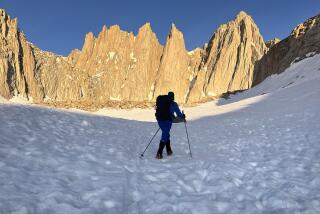Five giant steps for cold warriors
- Share via
Gone’s the day when snowshoes resembled tennis rackets strung by Vikings. Bent-hickory frames, webbing from caribou hides and wooden crossbars -- standard snowshoe components a century ago -- have been replaced by aluminum tubing, polyurethane-coated nylon and elastic snap-on bindings. Early snowshoes could span 5 feet, and at 10 pounds each, pass for foot barbells. Today there are few that top 2 feet or 4 pounds per pair.
Snowshoes have gotten hot in recent years as more and more people seek out nature during its most uncrowded moments, and as powder-tromping gear has gotten so advanced that even klutzes can use it. Maybe, too, because the ‘shoes have gotten pretty.
I knew that if I trolled shiny anodized aluminum past this section’s editor, he’d lunge like a largemouth at a glittery bass plug. Sure enough, he grabbed five pairs to test and hauled them to June Mountain on a family boarding and skiing trip. His report:
“It was already dusk, the end of a full day of boarding, when my 14-year-old son and I dragged two pairs of these shiny beauties down to the powder-dusted shore of Gull Lake.
A few days earlier, I’d ridiculed a friend for taking snowshoeing lessons. That struck me as the sort of contemptible behavior committed by people who sign up for extension classes titled “Fastener Safety: How to avoid injury in the use of buttons, snaps and zippers.”
But as my son and I flopped the bright red Yakimas and orange Atlases down in the fading light, I wondered if I might not have shown characteristic hubris.
Naw. Even with numb fingers and no instructions, it took less than a minute to pull the rubber straps over our footwear -- cheap hiking boots and an old pair of Sorels -- and set off along the shoreline. A long time ago a group of us went snow camping a few miles into the Sierra from Kennedy Meadows. Overnight a storm dumped several feet of new powder, and as we hiked out lugging our heavy packs, we sunk up to our hips every step or two. I spent each minute of that hike dreaming that I could somehow float atop the powder.
And that’s what my son and I did along the shoreline. In a few strides we were comfortable. Within minutes we were running, roostertails of snow kicking up behind us. The next evening my 17-year-old daughter joined us. The pivoting claws dug into a hillside as we climbed, and the webbing proved indestructible as we leaped off a snow-topped boulder in the dark. The accompanying collapsible poles proved harder to negotiate than the snowshoes.
On the final day, as the three of us got in one more day on the slopes, my skied-out wife, Pam, and our 19-year-old daughter took out the last two pairs -- one of which was plastic rather than aluminum -- and relished the less strenuous, more serene approach to snow travel and the empty spaces to which powder-walking took them. And they didn’t need any instruction from experts.”
Though he is smitten today, years ago he might have had snowshoe rage. The size, weight and design of vintage models forced wearers into unnatural gaits that could cripple ankles with extended use. Today’s snowshoes generally allow wearers to maintain natural strides even while ‘shoeing uphill, and virtually all are designed to suit specific tasks. One style of winter-ascent snowshoes from MSR features steel serrated edges that run the length of the shoes on both sides for unmatched traction while traversing.
Clearly, the new breed of snowshoe is exceptionally user-friendly if my editor was able to clamp on a pair and prance around like a colt without hurting himself. I made eight pairs available to him, but did I receive a shred of technical data? Nooo. Here, then, is information for five pairs of snowshoes, good examples of snow-walking technology’s cutting edge.
*
MSR DENALI EVO
The Evo is the premier offering in MSR’s impressive snowshoe collection, featuring steel traction blades and four-strap binding for a secure fit. The Evo can accommodate large footwear such as snowboard and ski boots. $170. (800) 531-9531, www.msrcorp.com.
*
REDFEATHER HIKE
These shoes were designed for recreational use, with maximum flotation in deep snow and bindings that are easy to get in and out of. And despite Redfeather’s well-deserved reputation for high quality, these snowshoes are surprisingly low in cost. $100-$130. (800) 525-0081, www.redfeather.com.
*
ATLAS 10 WOMEN’S ELEKTRA
This is one of the first snowshoes designed specifically for women. It’s smaller and lighter and its nose and tail shape are tapered to allow a more natural woman’s stride, and even the binding is tweaked to better fit a smaller foot. $250. (888) 482-8527, www.atlassnowshoe.com.
*
TUBBS ADVENTURE
Despite its name, the Adventure was designed for “exploring your backyard, local park or trail system” -- not the North Pole. Strengths include ease of use, adjustable bindings and low maintenance -- perfect for weekend outings. $160-$210. (800) 882-2748, www.tubbssnowshoes.com.
*
YAKIMA STARGAZER
This manufacturer’s design team took features from its top backcountry shoe as well as its top recreational shoe and came up with the hybrid. Expect this model to be user-friendly with comfy bindings and yet perform capably in demanding terrain. $170-$200. (888) 925-0703, www.yakima.com.
More to Read
Sign up for The Wild
We’ll help you find the best places to hike, bike and run, as well as the perfect silent spots for meditation and yoga.
You may occasionally receive promotional content from the Los Angeles Times.






